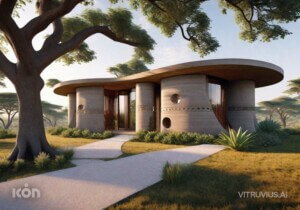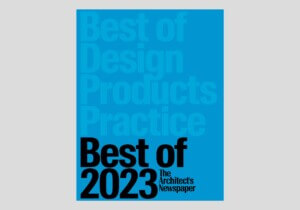At this year’s Best of Design Awards, winners were selected from 27 categories and each will take home a bespoke AN awards 3-D-printed trophy designed by Los Angeles studio Synthesis Design + Architecture (SDA) and fabricated by Somerville, Massachusetts–based printers Formlabs.
Founder and design principal of SDA and an assistant professor at the USC School of Architecture, Alvin Huang and his team settled on a final design after initially drafting up more than 20 ideas.
“We wanted to create an intricate, detailed form—something that would be impossible to do without a 3-D printer,” Huang said. To produce the design, Formlabs used transparent resin to reveal the design’s inner complexities. As part of his design process, Huang devised numerous iterations. “Parametric modeling makes everything smoother,” continued Huang.
The original design intent explored three-dimensional line drawings using modeling software such as Rhino and Grasshopper. However, after a number of tests, Huang ruled out this technique because of the laborious quantities of support material that were required to print. Instead, he employed a process that explored the variable scaling and extrusion of 2-D text to create a cloud of 3-D forms.
“It was important due to the time constraints that we revise the design of the trophy to match the constraints of the printing process of the machine. The change in direction allowed us to drastically reduce the amount of waste material printed (in the form of support structure) as well as the printing and post-production time,” Huang said.
The technique capitalized on the vertical movement of the material through the 3-D printer, enabling the detailed, intricate geometries of the individual letters to collectively form the trophy. The variable parameters that drove the model were the height of the extrusions, the scaling of the letters, and the density of the underlying matrix.
Huang was also pleased to work with Formlabs, which will be producing the physical award. The studio’s high-resolution 3-D printers made Huang’s design, in his words, “easy to achieve” and “smoothed out the processing of the designs.”
Zach Frew of Formlabs said, “We wanted to push the limits of 3-D printing with Synthesis’s design. This means that we started with the highest level of complexity and iterated downward—evaluating any changes needed in the design after each print. 3-D printing allowed us to rapidly develop prototypes and progress towards the final design.”
Frew continued, explaining that Formlabs’ high-resolution printers allowed Huang creative freedom. “Traditional manufacturing techniques are restricted in the level of complexity and detail they can achieve. Older subtractive technologies like CNC tooling are unable to resolve intricate details or create complex internal structures.”
“Because 3-D printing is an additive technology that produces one layer at a time with precision, more complex geometries can be created,” he said. “Synthesis’s design takes advantage of this. The Form 2 [printer] offers a very high level of detail and precision that makes relational designs easier and more reliable to produce. The machine typically produces parts with less than 200 microns of deviation from the original model. This means that designers can be confident that their models will function and relate as designed. SLA printed parts are also much easier to sand and post-process so modifications can quickly be made.”
Despite its prowess in the niche field, Formlabs prints more than just trophies. “3-D printing excels at creating rapid prototypes and visualizations,” added Frew. “Architects are able to produce scale models of their designs and ensure that each of the parts interact as desired. Printing tangible models that previously only existed within design software is an invaluable tool for helping architects to evaluate and iterate on their designs.”










